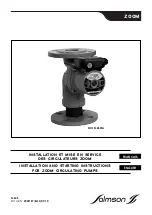
Notes for radio text:
The first 14 characters of the radio text will appear for
4 seconds and then they will scroll across the display.
If you tune in to an RDS station which is not
broadcasting any radio text, “No RT” will be displayed
when you switch to the radio text position.
While radio text data is received or when the text
contents change, “RT” will be displayed.
To recall stations in memory
■
To specify programmed types and select stations
(PTY search):
You can search a station by specifying the programme
type (news, sports, traffic programme, etc.) from the
stations in memory.
Press the TUNER button on the remote control or
FUNCTION button repeatedly on the main unit to
select TUNER function.
Press the RDS PTY button on the remote control.
“SELECT” and “PTY TI” will appear alternately for about
6 seconds.
Within 6 seconds, press the TUNING ( or ) button to
select the programme type.
Each time the button is pressed, the programme type will
appear.
While the selected programme type is flashing (within
6 seconds), press the RDS PTY button again.
After the selected programme type has been lit for
2 seconds, “SEARCH” will appear, and the search
operation will start.
Notes:
If the display has stopped flashing, start again from
step 2. If the unit finds a desired programme type,
the corresponding channel number will lit for about 8
seconds, and then the station name will remain lit.
If you want to listen to the same programme type of
another station, press the RDS PTY button while the
channel number or station name is flashing. The unit
will look for the next station.
If no station can be found, “Not Found” will appear for
a short while.
If you select the traffic programme:
If you select the traffic programme (TP) in step 3, “TP”
will appear.
(This does not mean that you can listen to the traffic
information at that time.)
When the traffic information is broadcast, “TA” will
appear.
●
●
●
1�
2�
3�
4�
●
●
●
Descriptions of the PTY (Programme Type) codes, TP
(Traffic Programme) and TA (Traffic Announcement)
You can search for and receive the following PTY, TP and
TA signals.
NEWS
Short accounts of facts, events and
publicly expressed views, reportage and
actuality.
AFFAIRS
Topical programme expanding or
enlarging upon the news, generally in
different presentation style or concept,
including debate, or analysis.
INFO
Programmes whose purpose is to impart
advice in the widest sense.
SPORT
Programme concerned with any aspect
of sport.
EDUCATE
Programme intended primarily to educate, of
which the formal element is fundamental.
DRAMA
All radio plays and serials.
CULTURE
Programmes concerned with any aspect
of national or regional culture, including
language, theatre, etc.
SCIENCE
Programmes about the natural sciences
and technology.
VARIED
Used
for
mainly
speech-based
programmes
usually
of
light-
entertainment nature, not covered by
other categories. Examples include:
quizzes, panel games, personality
interviews.
POP M
Commercial music, which would
generally be considered to be of current
popular appeal, often featuring in
current or recent record sales charts.
ROCK M
Contemporary modern music, usually
written and performed by young
musicians.
EASY M
Current contemporary music considered
to be “easy-listening”, as opposed to
Pop, Rock or Classical, or one of the
specialised music styles, Jazz, Folk or
Country. Music in this category is often
but not always, vocal, and usually of
short duration.
LIGHT M
Classical music for general, rather than
specialist appreciation. Examples of
music in this category are instrumental
music, and vocal or choral works.
CLASSICS
Performances of major orchestral works,
symphonies, chamber music, etc., and
including Grand Opera.
OTHER M
Musical styles not fitting into any of
the other categories. Particularly used
for specialist music of which Rhythm &
Blues and Reggae are examples.
WEATHER
Weather reports and forecasts and
meteorological information.
FINANCE
Stock Market reports, commerce,
trading, etc.
CHILDREN
For programmes targeted at a young
audience, primarily for entertainment
and interest, rather than where the
objective is to educate.
Using the Radio Data System (RDS) (continued)
DK-KP82PH_OM_EN_SCA.indd 17
2013-02-26 07:33:23











































